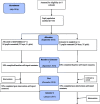The Effect of a School-Based Intervention on Physical Activity and Well-Being: a Non-Randomised Controlled Trial with Children of Low Socio-Economic Status
- PMID: 29679164
- PMCID: PMC5910444
- DOI: 10.1186/s40798-018-0129-0
The Effect of a School-Based Intervention on Physical Activity and Well-Being: a Non-Randomised Controlled Trial with Children of Low Socio-Economic Status
Abstract
Background: Self-determination theory (SDT) has been used to predict children's physical activity and well-being. However, few school-based SDT intervention studies have been conducted, and no research exists with children of low socio-economic status (SES). Therefore, SDT-derived needs-supportive teaching techniques informed the design and analyses of the Healthy Choices Programme (HCP). The aim was to determine if the HCP could enhance moderate-to-vigorous physical activity (MVPA) and well-being among children of low SES through increasing autonomy-support, needs satisfaction and intrinsic motivation.
Method: A mixed factorial two (group) × two (time) wait-list controlled trial was conducted and reported using the TREND guidelines. A total of 155 children (56% females; intervention n = 84, control n = 71) took part and completed measures at baseline (week 0) and post-intervention (week 11). The effect of the intervention on MVPA (model 1) and well-being (model 2) was tested through serial mediation models with three mediators (i.e. autonomy-support, needs satisfaction and intrinsic motivation).
Results: In comparison to the control group, the intervention was related to increases in MVPA (β = .45) and autonomy-support (β = .17). In model 1, analyses revealed partial mediation of the MVPA change through autonomy-support (β = .14), intrinsic motivation (β = .51) and all three SDT mediators in sequence (total r 2 = .34). In model 2, well-being was indirectly enhanced through autonomy-support (β = .38) and autonomy-support and needs satisfaction in sequence (total r 2 = .21).
Conclusions: The HCP enhanced MVPA and well-being by engendering a needs-supportive physical activity environment. The scientific and practical contribution of this study was the application of SDT in all aspects of the HCP intervention's design and analyses. Practitioners may consider integrating SDT principles, as implemented in the HCP, for health promotion.
Trial registration: This study is registered on Research Registry (number researchregistry2852 ).
Keywords: Behaviour change; Health promotion; Motivation; Needs satisfaction; Physical education.
Conflict of interest statement
Ethics Approval and Consent to Participate
Informed consent and assent was sought prior to this study. Ethical approval was granted by the Ulster University, in which we adhere to the Declaration of Helsinki throughout all ethical procedures.
Consent for Publication
The Ulster University approved this study for publication.
Competing Interests
Stephen Shannon, Gavin Breslin, Donncha Hanna, Zoe Younger, Deirdre Brennan and Jessica Hassan declare that they have no competing interests.
Publisher’s Note
Springer Nature remains neutral with regard to jurisdictional claims in published maps and institutional affiliations.
Figures






Similar articles
-
Web-based need-supportive parenting program to promote physical activity in secondary school students: a randomized controlled pilot trial.BMC Public Health. 2023 Aug 25;23(1):1627. doi: 10.1186/s12889-023-16528-4. BMC Public Health. 2023. PMID: 37626288 Free PMC article. Clinical Trial.
-
Motivational processes in physical education and objectively measured physical activity among adolescents.J Sport Health Sci. 2020 Sep;9(5):462-471. doi: 10.1016/j.jshs.2019.06.001. Epub 2019 Jun 8. J Sport Health Sci. 2020. PMID: 32928449 Free PMC article.
-
Increasing students' physical activity during school physical education: rationale and protocol for the SELF-FIT cluster randomized controlled trial.BMC Public Health. 2017 Jul 11;18(1):11. doi: 10.1186/s12889-017-4553-8. BMC Public Health. 2017. PMID: 28697797 Free PMC article. Clinical Trial.
-
Effects of a standard provision versus an autonomy supportive exercise referral programme on physical activity, quality of life and well-being indicators: a cluster randomised controlled trial.Int J Behav Nutr Phys Act. 2014 Jan 29;11:10. doi: 10.1186/1479-5868-11-10. Int J Behav Nutr Phys Act. 2014. PMID: 24475766 Free PMC article. Clinical Trial.
-
A meta-analysis of techniques to promote motivation for health behaviour change from a self-determination theory perspective.Health Psychol Rev. 2019 Mar;13(1):110-130. doi: 10.1080/17437199.2018.1534071. Epub 2018 Oct 16. Health Psychol Rev. 2019. PMID: 30295176
Cited by
-
Differences and Associations between Physical Activity Motives and Types of Physical Activity among Adolescent Boys and Girls.Biomed Res Int. 2022 May 31;2022:6305204. doi: 10.1155/2022/6305204. eCollection 2022. Biomed Res Int. 2022. PMID: 35686232 Free PMC article.
-
Physical activity interventions in European primary schools: a scoping review to create a framework for the design of tailored interventions in European countries.Front Public Health. 2024 Feb 8;12:1321167. doi: 10.3389/fpubh.2024.1321167. eCollection 2024. Front Public Health. 2024. PMID: 38389941 Free PMC article.
-
Intervention Programme Based on Self-Determination Theory to Promote Extracurricular Physical Activity through Physical Education in Primary School: A Study Protocol.Children (Basel). 2023 Mar 3;10(3):504. doi: 10.3390/children10030504. Children (Basel). 2023. PMID: 36980062 Free PMC article.
-
A Preliminary Investigation of the Relationship between Motivation for Physical Activity and Emotional and Behavioural Difficulties in Children Aged 8-12 Years: The Role of Autonomous Motivation.Int J Environ Res Public Health. 2020 Aug 3;17(15):5584. doi: 10.3390/ijerph17155584. Int J Environ Res Public Health. 2020. PMID: 32756316 Free PMC article.
-
Characterizing Middle School Students' Physical Literacy Development: A Self-Determination Theory-Based Pilot Intervention in Physical Education.Front Sports Act Living. 2022 Jan 12;3:809447. doi: 10.3389/fspor.2021.809447. eCollection 2021. Front Sports Act Living. 2022. PMID: 35098123 Free PMC article.
References
-
- Deci EL, Ryan RM. Hedonia, eudaimonia, and well-being: an introduction. J Happiness Stud. 2008;9:1–11. doi: 10.1007/s10902-006-9018-1. - DOI
-
- Breslin G, Fitzpatrick B, Brennan D, et al. Physical activity and wellbeing of 8–9 year old children from social disadvantage: an all-Ireland approach to health. Ment Health and Phys Act. 2017;(13):9–14.
LinkOut - more resources
Full Text Sources
Other Literature Sources
Miscellaneous

